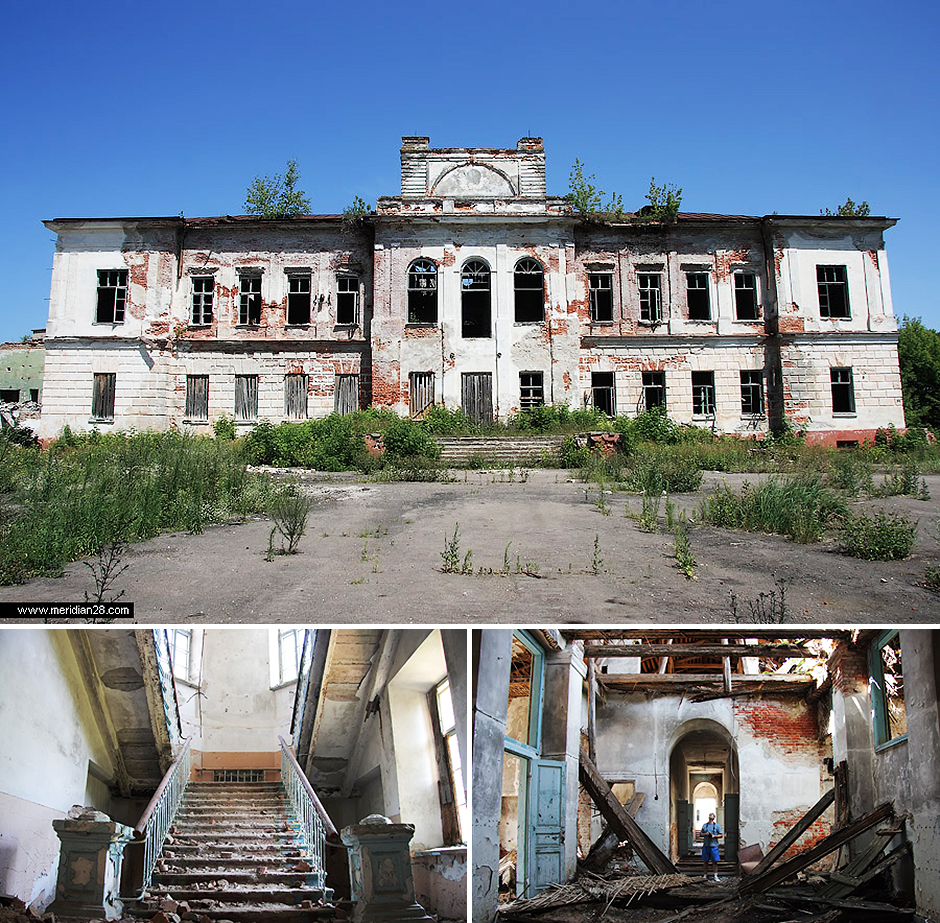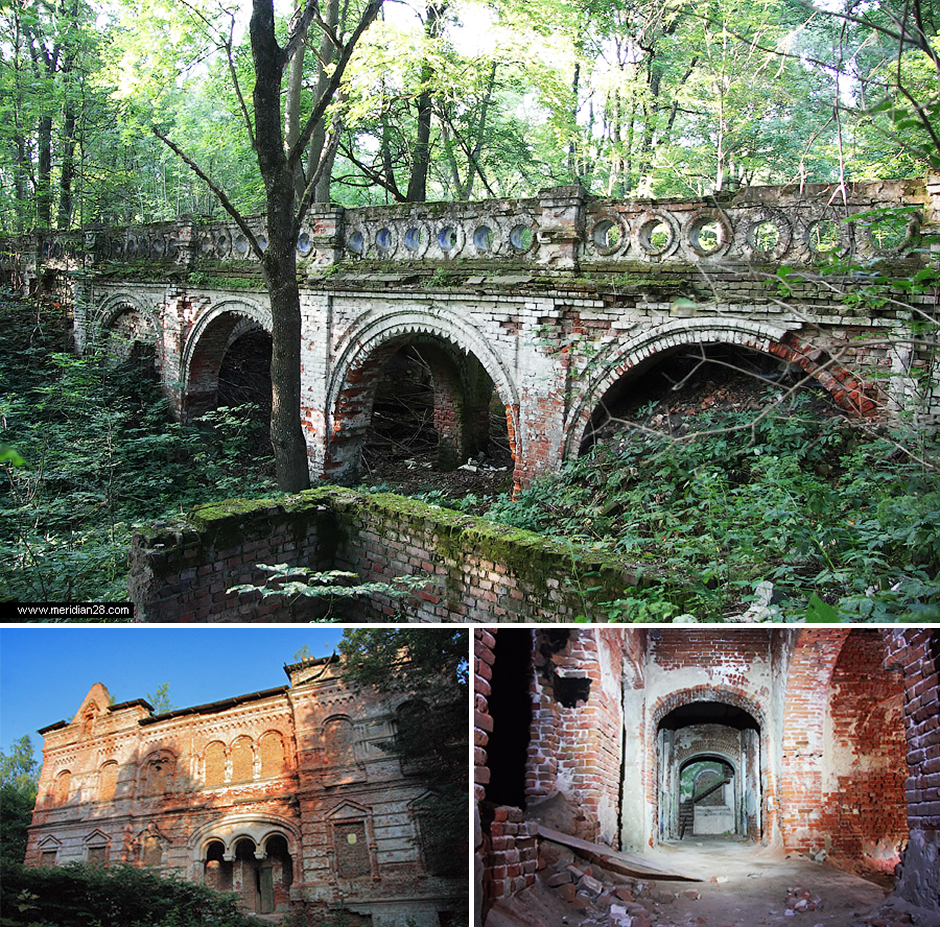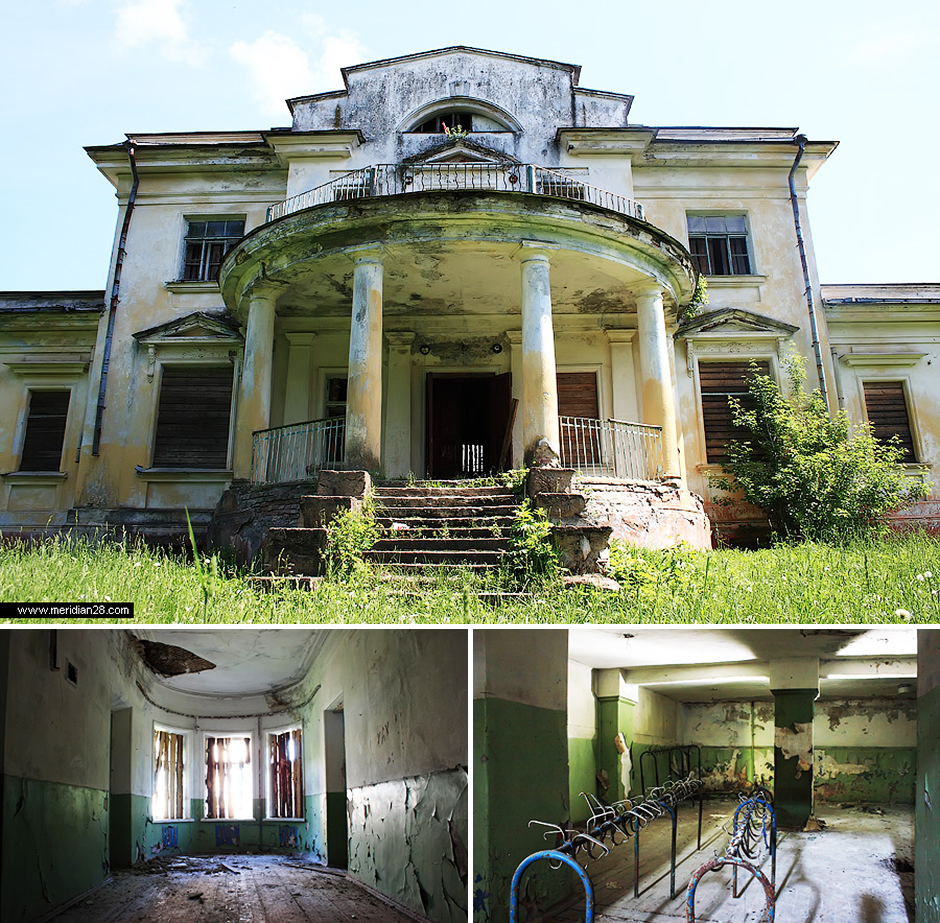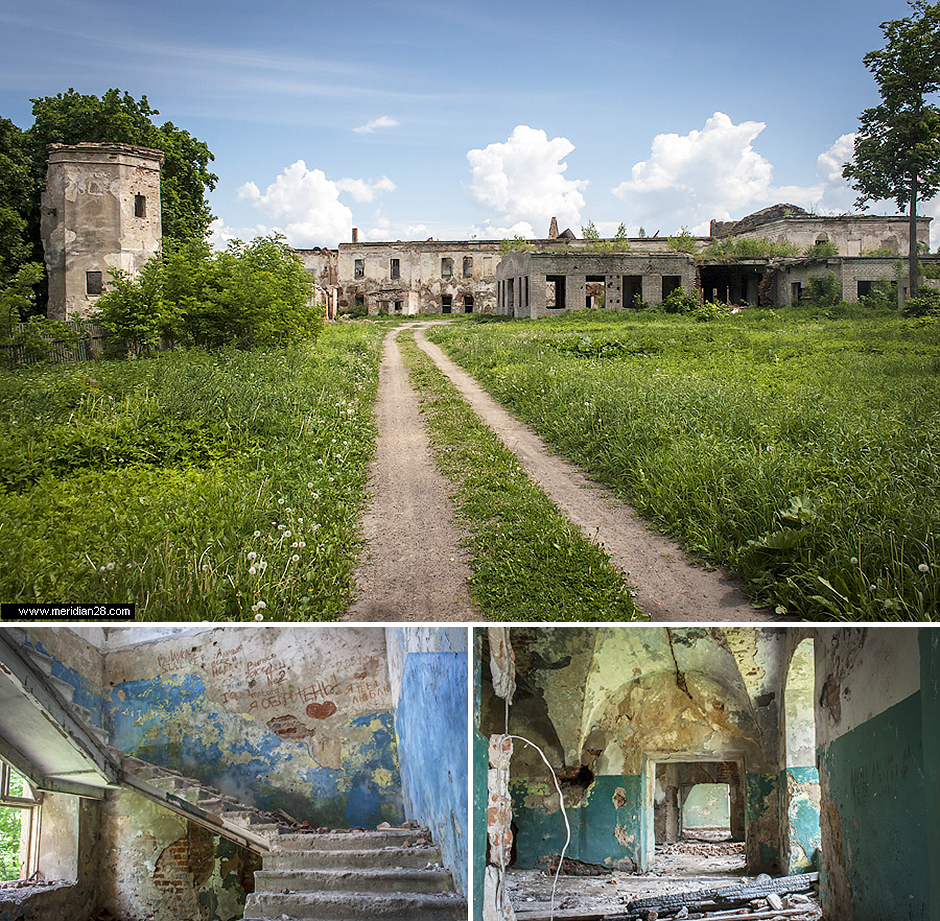Abandoned Belarus. Part Two
- 03.09.2016
- 37249

The Harvaty mansion
Naroulya town
One of the richest mansions of the Palesye region of the 19th century is waiting for you in Naroulya. A big classical style house was a diamond of a provincial town. The complex included not only a magnificent farm but also a landscape park which is just three times smaller than the modern Gorky park in Minsk. At that time the cult of nature and developing landscape potential were in fashion so every passage was thoroughly planned so that it imitated life in the forest. Now a half-destroyed fountain with massive concrete benches, a small creek in the northern part of the park and the access to the river are what remained of what used to be here.
In the middle of the 1860s Daniil Harvat, the owner of the mansion, quitted Naroulya and went to a new house in Kiev province. Before the October Revolution the mansion was being restored but after the Revolution the restoration process stopped. For the next couple of years the mansion suffered a lot: at first it served as a school, during the Second World War its rich decorations were destroyed; after the war it again became a school, and as a result of this last transformation the mansion got stripped of all the remaining historical elements. The Chernobyl nuclear accident put an end to this story: everybody fled from Naroulya.
Now the complex is fenced but it doesn't prevent from getting inside and from walking in its rooms. Climb the front stairs and get into the dining room situated on the first floor. On the right one could see a "red" area with a bizarre floor which was composed from various kind of wood so it looked like an oriental carpet. On the other side there was a "blue" area: the walls were covered with sky-blue satin and golden stars were painted on the ceiling. The owners used to write on the walls so that their inscriptions looked like real paintings. Thus, one could read in a blue part of the room: "It is as a surprise that flowers do not grow under your feet. You are a paradise, you are May, you are spring". Those who come to see the mansion are delighted with these inscriptions on the walls but now they are not so positive: for example, one of them says "There's no happiness in life".
The mansion still can surprise the most attentive of us: there are the remnants of the floor of the 19th century in the basement, which is situated in the eastern part of the house; around here there are a lot of interesting buildings that are still not occupied by the locals: a distillery, a chapel, the gates and an arbour.
Read more here

The Herardy Mansion
Dzyamjanki village, Dobrush district
One of the most mysterious places of Belarus is situated in Dobrush district in the mansion of the Governor-General of Finland Mikalaya Herard who governed these territories before the Revolution. Here, right in the middle of a deserted after the Chernobyl accident village, a small brick palace in pseudo-Russian style is situated; in addition, it's surrounded by a defense trench. It's said that here lives a ghost of Herard's daughter who committed suicide because of unhappy love.
The estate is situated on a high hill with a defense trench around it – one can get into the house crossing the almost collapsed bridge with interesting styling and four arches. The palace is surrounded by 7 hectares of a 2-level park where a rich collection of rare species of trees which survived up to now can be found. The windows of the building are bricked up so take a lantern with you and go ahead! One of the best attractions of the palace is a wrought-iron staircase leading to the attic.
The Herardy mansion is situated within the Chernobyl exclusion zone and one can get there only with a special permit as the only road leading there is blocked by a check point where policemen don't let proceed further if one doesn't have this permit. By the way, we advise you not to go this palace on your own at night: as this place is abandoned you can encounter a herd of wild boars which are living in the area.
Read more here

St. Anthony Catholic
Church Knyazhitsy village, Mahilyou region
It’s a miracle that a stone catholic church built in the 18th century survived in a half-abandoned Knyazhitsy village. This church makes an interesting contrast with quiet rural surroundings. The first temple on this spot was built from wood in 1681; later a stone church was erected here. During the uprising lead by Kalinouski the church was closed; then it was decided to make an Orthodox church out of it – three pseudo-domes were attached and after that the enthusiasm faded away. Fifteen years ago the church was going to be restored but again there was enough enthusiasm only to put up scaffolding which is still there – collapsing gradually together with the church.
On the inside the church is well preserved; there are no columns there, and thanks to that and to the height of 15 meters (which is higher that a five-floor building!) the church amazes with its lightness. It’s an ideal place to slow down a bit and listen to yourself.
Read more here

Holy Trinity Church
Samatsevichy village, Kastsyukovichy district
There’re a lot of "black" spots on the map of Belarus due to the Chernobyl nuclear accident. The radioactive cloud covered one third part of the Mahiliou region which became the exclusion zone.
Samatsevichy village, where the poet Arkadz’ Kylyashou was born, also became part of this zone. Before the exclusion there lived 3000 people, there was a decent hospital, a couple of shops, a garden and even a café! Now all this is buried in the hill to stop radiation. Only a few buildings survived and one of them is Holy Trinity Church. It’s a church that once was situated in the center of a prosperous village; it was quite a big church for our country – it’s as high as a ten-floor building. It was built in 1842 in the retrospective Russian style. But to tell the truth, the church has been completely plundered – the looters have even taken away the floors. Check out the tombs, walk around the church – on the facade of the church amazing inscriptions on Church Slavonic have been preserved. In theory, you can get there only with a special permit; but in practice, if you get lost even policemen will tell the quickest way to the place.
Read more here

The mansion of the noble Tolstoy family.
Grudzinauka village, Byhau district
One of the most beautiful places of the area is the Tolstoy mansion. Even though Leo Tolstoy never visited it this is definitely worth your visit. An amazing palace with a dome, columns, a front staircase and an open terrace overviewing the park are waiting for you.
Take a proper walk in the park of 10 hectares and find there a Siberian Cedar which is more than 100 years old. Later walk around the palace where just until recently a school and a sanatorium for children ill with rheumatism were operating. That accounts for its walls being half-painted in green and for the fact that there’s a typical of the Soviet Union cloak-room with its tickets. This all doesn’t match with the architecture of the mansion at all.
Read more here

Byhau castle
Byhau town
Once you have visited the Tolstoy mansion go right to Byhau – here an abandoned feudal palace built in the beginning of the 17th century is lonely awaiting its last day. It was built by the Hetman of the Grand Duchy of Lithuania, Karl Khadkevich, a terror for the Swedes and a defender of Europe from the Ottoman Empire. In 1621 Byhau was transferred to Leu Sapeha, the Chancellor, who decided to upgrade the castle and make a bastion fortification out of it. Thus, a defensive wall 800 meters long, a defense trench and a couple of bastions were attached to the complex so that the city was reliably protected.
Later Byhau was annexed to the Russian Empire and the fortress stayed unused so its mighty walls were gradually falling apart, and in the 19th century the complex was transformed into a prison. Later the castle got even more demoted: it served as a military barracks and then as a factory. Now the state of the palace leaves much to be desired – several times the ruins were burning but fire can damage absolutely every place.
Now this palace can show you how the youngsters of Byhau live and spend their free time and offer you a magnificent view over the Dnieper river.
Read more here
Text by Nasta Eroha
Photo by Meridian’28
Translation by Alexandra
Читать еще:
Дагрукацца да нябёсаў
У новай рубрыцы Mediascape разбіраемся, як напісаць першакласны прэс-рэліз, каб ад яго майточкі змакрэлі.
Куды прыводзяць мары
Казуркі, чэрці ды іншыя міфічныя істоты – у выставе харкаўскіх фотамастакоў Андрэя Рачынскага і Данілы Рэўкоўскага.
На главной:
«Здесь красивые люди красиво пьют»: интервью с создателями бара «Молодой»
Как построить не просто бар, но тусовку на районе.
«Здесь красивые люди красиво пьют»: интервью с создателями бара «Молодой»
Как построить не просто бар, но тусовку на районе.
Художник Павел Булва: «Этому миру чуждо все, что мне важно»
Разговор о смыслах большого искусства.
Self-made беларуски – о том, что их вдохновляет и заряжает. Часть 1
Правила жизни, работы, отдыха.